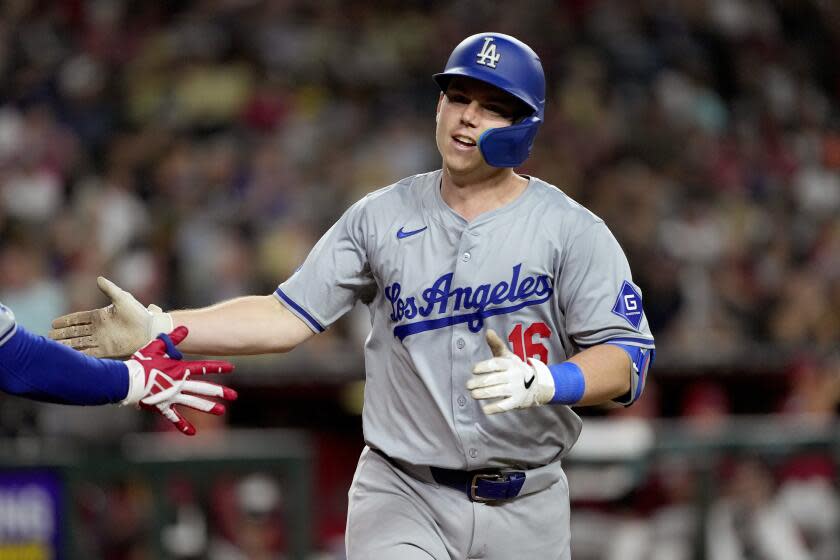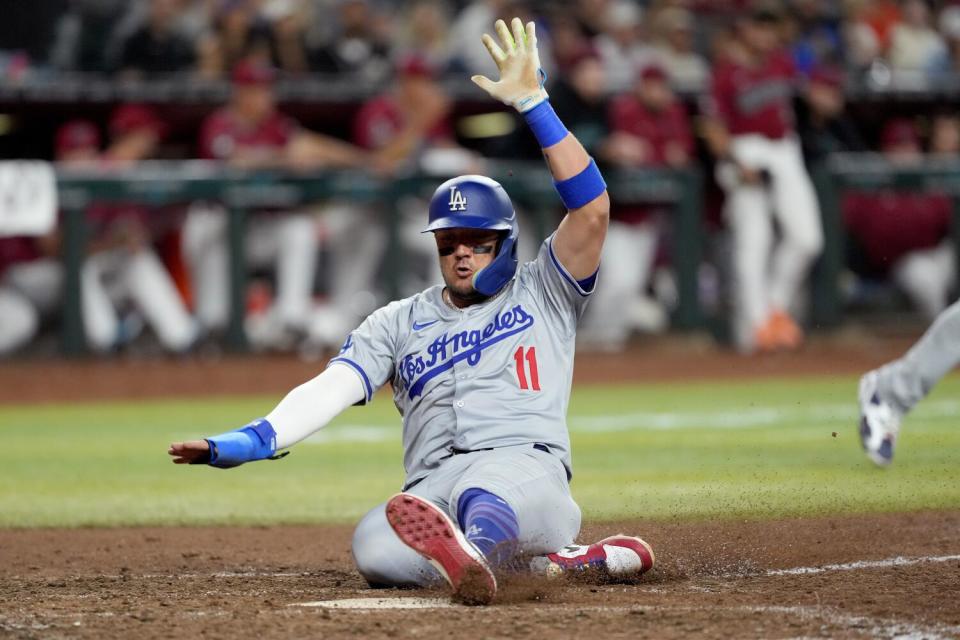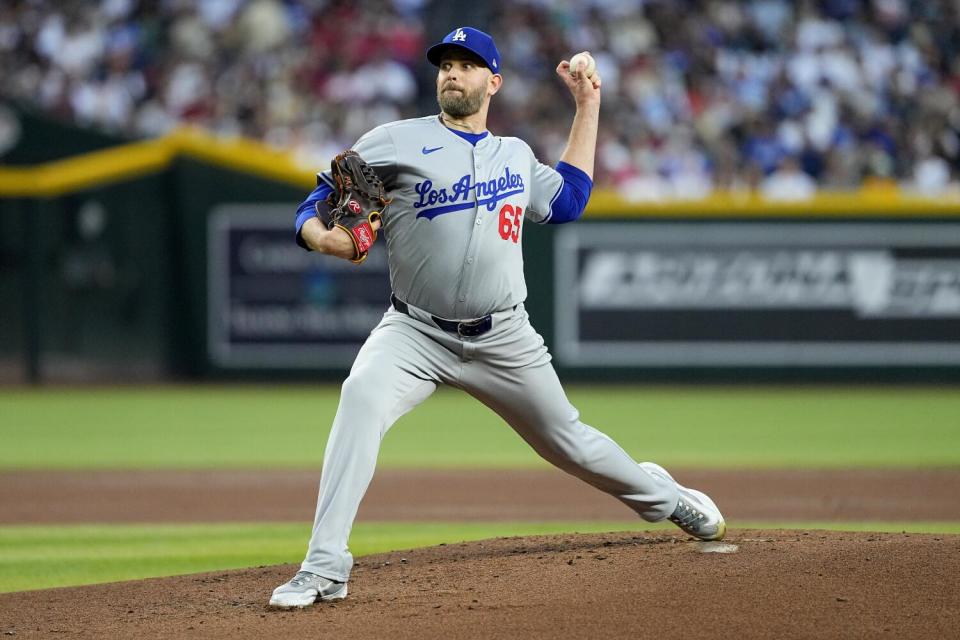Dodgers shine with strikeout-free plate performance in win over Arizona

At first, Kiké Hernández thought the Chase Field scoreboard operator had given up.
After the first out of the ninth inning in the Dodgers’ 8-4 win over the Arizona Diamondbacks on Monday night, Hernández was signaling across the outfield to teammate Andy Pages, when an unusual sight suddenly caught the corner of his eye.
Above the right-field bleachers there is a Circle K-sponsored strikeout counter on a digital monitor. Every time the home team punches out a batter, one of the convenience store’s red K logos is added to the ribbon.
Only on this night, Hernández noticed the screen was empty.
“I thought the team just kind of gave up on the game,” he said. “And removed all the Ks.”
Read more: How Freddie Freeman — now back on a hitting streak — worked through early-season slump
Then, he realized there was a more impressive reason why.
Even after 44 plate appearances, 17 two-strike counts and 36 two-strike pitches to Dodgers hitters, not a single one of them struck out.
For the first time since 2006, the Dodgers’ lineup went down on strikes zero times.
“What the [heck]?” Hernández started thinking. “No Ks?”
Instead, in a continuation of the team’s improved plate discipline, the Dodgers didn’t cave to Diamondbacks pitching, even when behind in the count. When facing two strikes, they recorded three hits, put 14 balls in play, took 12 pitches for balls, fouled 10 off — and, most importantly, whiffed zero times.
“I just think you gotta give the players all the credit, as far as winning pitches, fighting to move the ball forward,” manager Dave Roberts said. “There’s got to be a definitive two-strike approach. You’ve got to have some bat to ball. You’ve got to value that. And our guys do. They’re showing it.”
Even if none of them actually noticed the accomplishment unfolding. Aside from Hernández, who confirmed the feat with hitting coach Robert Van Scoyoc in the victory handshake line, no one on the field noticed until the end of the night.
“Is that what we did?” first baseman Freddie Freeman said when asked about it.
There was universal agreement on the difficulty of the task.
“In today’s game?” third baseman Max Muncy said, referencing a long-growing, leaguewide trend of increasing strikeouts. “It’s really freaking hard.”
“With the kind of stuff [pitchers] have, to not strike out? Didn’t know that,” Freeman added. “That’s pretty cool.”
Shohei Ohtani faced the first two-strike situation in the first inning, surviving a couple of potential putaway pitches before bouncing a single to center field.

After Hernández tied the score at 1-1 with a double in the top of the second, Andy Pages put the Dodgers in front with a two-strike sacrifice fly.
The biggest two-strike hit came from Teoscar Hernández in the fifth when he hammered a 1-and-2 pitch for a bases-loaded, ground-rule double, scoring two runs with a deep drive that one-hopped into the Chase Field pool.
“I know I’m the one [of the ones] that’s been missing a lot of at-bats with men in scoring position, especially bases loaded,” Hernández said afterward, referencing the Dodgers’ struggles in both situations entering the night.
“In that situation, I tried to put the ball in play and get at least one, and I got the double.”
And after Pages added another bases-loaded, two-run double later in the inning, opening up a 6-1 lead, the Dodgers largely cruised, recording their seventh win in eight games.
“Just overall,” Roberts said, “a great offensive performance.”
Read more: Shaikin: Risk and reward: This ex-Dodger used to throw 91 mph. Now he throws 97
It was only a few weeks ago that strikeouts seemed like an early season weakness for the Dodgers’ lineup. On April 20 — the final day of a 3-7 skid that left the team just a game over .500 — their 221 strikeouts led the majors. In almost one out of every four plate appearances to that point, opposing pitchers set their hitters down on strikes.
Since then, though, the team has refined its approach and improved its plate discipline. Even before Monday, its 13.8% strikeout rate over the last week was the lowest of any team.
“We didn’t have any emphasis on cutting down strikeouts,” Freeman said. “It was just to be more on time to heaters because that’s when we’re at our best, is when we’re hitting fastballs. We weren’t doing that when we were going through that tough stretch.”
Roberts referenced another sport to explained the change.
“I just like the way that we’re getting hits, and not just going for slug,” he said. “I always use a golf analogy: Our guys are using different clubs, and you have to to play baseball.”

Still, for the rarity of the accomplishment — only four teams had zero-strikeout games last year, and none before that since 2017 — the Dodgers’ strikeout total wasn’t exactly front of mind.
Freeman said the lineup was happier with the overall production, after the Dodgers finished with 10 hits, eight walks and a four-for-11 mark with runners in scoring position. Teoscar Hernández said he was more impressed with how the club executed its approach.
Still, after shortstop Miguel Rojas was informed of the strikeout total, he headed to the showers yelling at his teammates somewhat jokingly, but also with a tone of genuine excitement.
“Hey congratulations!” he shouted as he disappeared from sight. “We didn’t strike out today one time.”
Sign up for more Dodgers news with Dodgers Dugout. Delivered at the start of each series.
This story originally appeared in Los Angeles Times.
